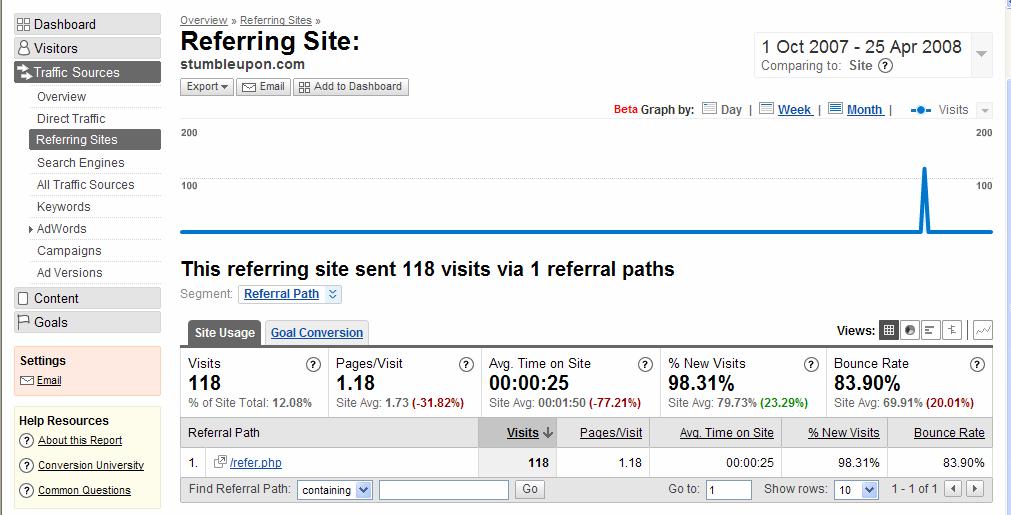Breaking into Social Bookmarking

This post has been a bit of time coming, I think. Actually the last time I wrote about Social Bookmarking, I had been thinking about it for a while. It’s not a particularly easy topic to write about and I always end up waffling, so you’ll have to bear with me tonight. What I want to talk about is my experiences with social bookmarking on this blog and in general. But we’ll start from this blog:
I’ve been playing around with Stumbleupon for a bit now. It is interesting for me because for the sites that I look after it provides a steady stream of traffic. It is the most consistent of the lot of them – it generates small volumes of traffic in a constant stream as opposed to the large spikes that I see on other social networking sites.
How does it work?
You download the toolbar for your browser. You browse the web. When you find something you like, you click thumbs up in the toolbar. If nobody has seen it before, then you can write a little blurb about it. You also have a button that says ‘stumble’. You click on it and it takes you to a random page that other users have thought was good. If you set up your profile correctly it takes you only to the pages that are in your interest realm. You can view lots of interesting pages and just stumble onto a new one. It’s quite addictive.
What happened to whencanistop.com?
Whilst playing around, both myself and Henry decided that we would put a thumbs up to the whencanistop home page. You can give it a thumbs up too if you like. In fact, if you do like a site, why not give it a thumbs up – it’ll give other people who like what you like more chance of finding it. Having got two people to click it, I suddenly got a spike in my site traffic:

There you go – I got 118 visits in basically the space of an hour. Did anything come of it? Not really – it was fairly untargetted and I’m a real niche website. But most websites aren’t – you should really be able to find people who will be interested in your subject line.
What should I do?
Get everyone you know to download the stumbleupon toolbar. Get them to put thumbs up to pages they like and thumbs down to ones that they don’t. Include your own pages in this analysis. It’s a community – so if a page is good then it’ll get lots of thumbs up and do well. If it’s not good then it’ll get thumbs down and will drop like a stone, probably dragging the rest of the pages on stumbleupon with it. This means that there is no point spamming by giving thumbs up to all posts.
Slashdot was something that I joined a couple of months ago and had been looking around, but hadn’t really been doing anything with until recently. Until the other week that is:
How does it work?
Slashdot works in a slightly different way. Firstly you don’t actually have to be a member to post things, but it helps (I think). What you do is go to the slashdot entry form and fill in the url that you want to post as well as a little information about it. Slashdot’s very efficient moderators then go through the entries and decide which ones are worth putting on the site. The stories that are posted stay on the home page until they are shunted down from above. Every day Slashdot sends its users an email with the stories from the previous day with links.
What happened to whencanistop.com?
This is where it all gets interesting. I was looking at a post by Aurélie Pols on the OX2 Web Analytics blog about Yahoo! taking over IndexTools and making it free. I gave my name as my blog post and submitted it. Imagine my surprise not long later when I noticed that I was top of Slashdot!!! Anyway, I wondered where the traffic would go for this one and it clearly wasn’t to me:

I’d be interested to hear (if anyone over OX2 can tell me that’d be great) how much traffic that it generated for the other links in the site. The thing I did notice though was that for days afterwards I was getting referrers that were clearly email programmes – people clicking through on the email that was sent afterwards.
More importantly though – look what it has done for the number of links that I have to my site now on Yahoo! Site Explorer (this may look much lower now, but it was up in the 60s at one point because of all the RSS feeds). Add into that if you do a search in Google for whencanistop, whereas before there were very few pages, there are now hundreds (801 for me today) – even if I now have been pushed off number one by slashdot.
What should I do?
Sign up to Slashdot. Submit articles that you think are interesting. Don’t spam. This is really important, so I am going to say it again. Don’t spam. Seriously – only 10 or so articles go up on their pages every day. If you keep sending them submissions that don’t help you, then you aren’t going to get any response after a while because they’ll recognise you and filter you out. Only submit stuff that they’d find interesting – it’s mainly tech and science.
I think I mentioned this in my last report. Digg is an unusually site because it seems to generate huge volumes of traffic (or can do if it sits for a long time) but doesn’t seem to have any obvious pattern about when (even if this person claims to know)
How does it work?
Digg works in yet another slightly different way (although it is more similar to Stumbleupon). You have stuff on your site that people like. They digg you. How do they digg you? You see pages with little ‘Digg this’ signs next to them (stories on the Guardian always seem to have this). I’d recommend it. Sign up to Digg and then digg your favourite stuff. Digg has a system whereby if it gets a certain number of diggs in a space of time, it will shoot it up the home page and then get more people going to it. If there are lots of people going to it and digging it again, then it will get even higher. If people go there and don’t digg it, then it’ll slide back down again (very similar in this sense to www.reddit.com).
I’d recommend signing up to all of these services and using them frequently. How frequently? All the time. If you’re looking at the bbc, digg it. If you are researching an article or post and find something relevant, stumble it. The thing I like about stumbleupon is that it lets you look at all the pages you stumbled. You can then use this information to help you write your story (because all the links that you need are in one convenient place).
And don’t forget to stumble this blog 🙂

Two things you need to consider that are affecting your results.
How to get more Diggs concerns how Google may find to be spamming Digg.
Also Google ranks blogs completely differently than you think.
Both of these articles will explain the Google effect on your blog and how it ranks due to Digg links.
The “no effect” comment on Digg is a little inaccurate because the particular article should have done better due to a slightly popular Digg post.